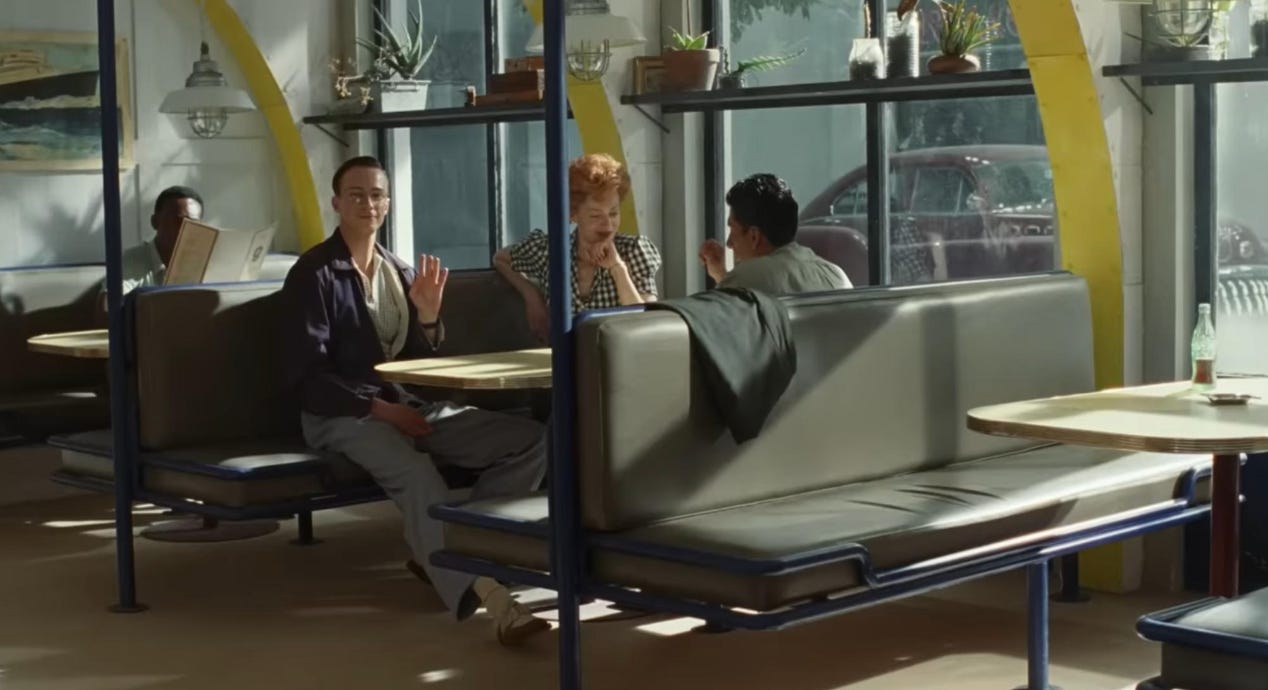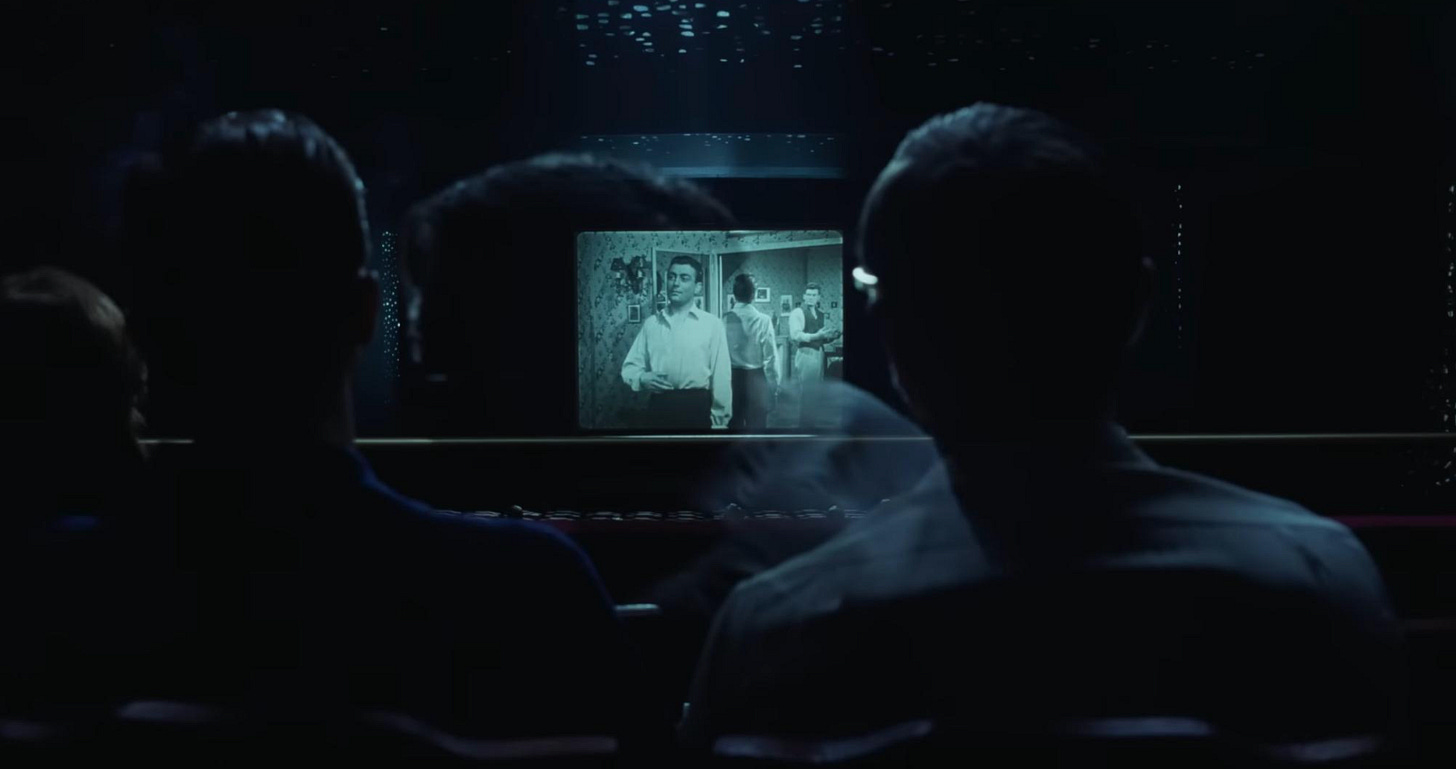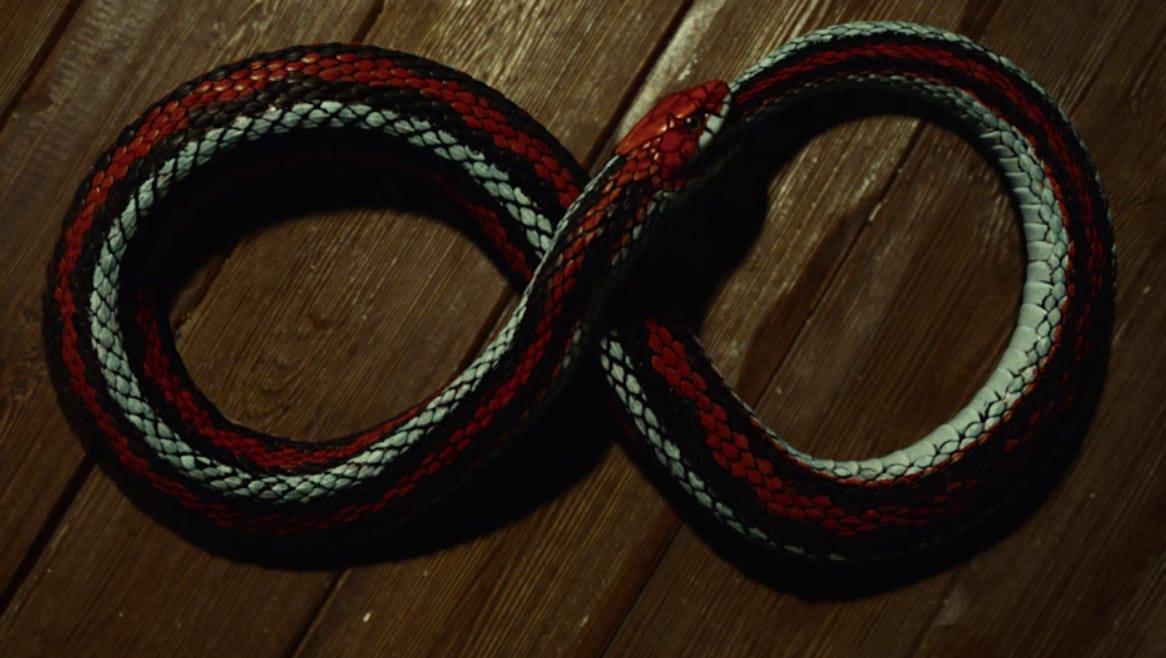Sandwiched between the release of Wicked and Nosferatu, Queer comes as Luca Guadagnino’s (director, famously of Call Me by Your Name) latest masterpiece. The film follows one William Lee “Lee”, a 50-or-so-year-old American expat living in Mexico City. He keeps himself entertained throughout the city primarily by hanging around a gay bar, where it is clear he is an alcoholic, and as is later revealed, a heroin addict. It’s at this bar where Lee becomes entranced by a young, handsome, fellow veteran, Eugene Allerton early on—and whom he forms his life around. The film is lustful, turbid, and honest, all at once.
Director Luca Guadagnino and Daniel Craig, who plays Lee, have discussed in interviews their intention of displaying the raw emotion, particularly which comes with the desire and yearning, of queer relationships in the piece. Lee and Allerton’s relationship is tumultuous, with Lee’s nearly uncontrollable desire to become closer with Allerton—who deliberately avoids the topic of being queer in any sense. His (Allerton’s) feelings toward his relationship with Lee shift almost erratically, from welcoming Lee’s advances, to throwing him to the floor in rejection. However, the film is not simply a love story. Rather, it is both a morbid commentary on queer relationships and life in the 1950s as well as a piece that cherishes intimacy.
A Contextualization of Queer’s Creator, William S. Burroughs
To understand the narrative of the film, it’s important to understand the context in which it was written. The film is a direct adaptation of a novella, which shares the same name, written by William S. Burroughs in 1952 (though not published until 1985). Burroughs lived a tumultuous life—he had been born and raised in a wealthy, upper-class White midwestern family in Missouri before he would go on to study anthropology at Harvard. As he grew older, however, his life would increasingly spiral out of his control.
Burroughs found himself traveling throughout Europe, indulging himself in local gay culture, living on a plentiful allowance from his parents. He would enlist in the Army for a short amount of time following the bombing of Pearl Harbor, however, he was discharged due to his worsening mental health issues. Burroughs then moved to none other than New York City, where he befriended Jack Kerouac. Together, the two have left an enormous legacy for their roles in inciting the 1960s hippie movement, as part of the Beat Generation.
Finally, atop the various struggles he would face in adulthood, Burroughs would go on to marry twice. He had two wives, neither of which he had romantic excursions with, and had married more or less out of practicality. He, of course, had been a closeted gay man since his teenage years. It’s widely believed that the trauma and depression Burroughs projected into much of his later writing was rooted in the accidental death of his second wife, Joan Vollmer, who he’d killed whilst drunkenly playing a game of William Tell. This incident would be portrayed at the end of the film, in one of Lee’s final hallucinations. Allerton stares at Lee silently, before Lee pulls the trigger. Though incredibly morbid, the scene has been interpreted to symbolize Lee’s desperation for freedom from a relationship that has brought him little good, as will be discussed below.
A Flurry of Color, Sound, and Dress
It feels cliche to call the film a “work of art”. Yet, Luca Guadagnino truly had no shortage of artistic visions for the film. Now 53 years of age, Guadagnino has told interviewers that he had wanted to adapt the story of Queer into a film since he was 17 when he’d first read the novella. Each frame is miraculously drowned in color, as my friend Basil would point out to me. Whether it be the motel in which Lee has a brief affair with a young Mexican man or the bar in which he spends the majority of his days, each setting feels to be a painting in of itself.


Another distinct visual component of the piece is Lee’s clothing—apart from just a few brief moments in the film, he wears exclusively a loose-fitting, white suit, with white pants and a white button-up. In one interview, Guadagnino and Daniel Craig praise the film’s costume designer—JonathanAnderson—for his characterization through the fabric. Craig discusses how the clean-cut, clear-colored outfit served both as a visual and emotional contrast to Lee’s character. Craig says that he believes “‘[Lee] is a functioning drug addict [and] alcoholic in the truest sense of the word – [in that] he functions.’” Lee dresses himself in an organized manner, he brushes his teeth, combs his hair, and “‘does all the things he's supposed to do, and then takes drugs. That's a beautiful contradiction.’”
In one last artistic observation, the film’s soundtrack works wonders as well—It stretches from classic sounds of the 1950-60s and a number of original pieces. These were chosen, of course, to connect to the historical context in which Burroughs, the author who inspired the piece, had lived as, essentially, a hippie. But peculiarly, Guadagnino also includes three Nirvana tracks—a cover of “All Apologies,” “Come As You Are,” and “Marigold.” The reasoning behind this, Guadagnino says, was “because I think Nirvana, in a way, is connected with Burroughs historically. And because this is a movie for now, I felt that Burroughs was bridging with Nirvana and Nirvana were bridging with the audiences now. There was this kind of emotional knot in the anguish of [Nirvana's] music that could be really played properly in the movie that we were doing.” This is all merely to say that Burroughs was an early hipster, but a damn existential one.
The Symbolism of Yagé
Queer’s narrative becomes clearer as Lee expresses his desire to study yagé, or ayahuasca— a plant with hallucinogenic properties found deep in the Amazon rainforest. The plant is believed by those who use it to have telepathic properties, which hooks Lee’s interest. Historically, it’s used most commonly in rituals performed by indigenous tribes in the region, meant for spiritual healing.
Admittedly, Lee’s sudden interest in the plant makes it seem as though the film has lost its own plot. But this component is crucial when we consider the life of Burroughs. As a writer, he is largely considered to be a pillar of the Beat Generation—a cultural movement in post-World War II America, which would lead to what is popularly known as the hippie movement of the late 20th century. Today, the movement is largely associated with Jack Kerouac, a close friend of Burroughs. Thus, the presence of drugs, the disillusionment toward society, and the desire for deeper spiritual endeavors is central to Queer. Yagé, and the component of magical realism that is associated with it, works to unravel the idea of desire in the film.
Yagé finds its role in the film as a tool for intimacy. Put bluntly, Lee is enraptured by Allerton. His head and his heart are simply reduced to, or perhaps clarified to, want one thing—closeness. Unfiltered intimacy. His interest, then, in yagé is really rooted in his desire to understand the man who he is entranced by. So when scenes depict Lee imagining himself kissing Allerton on the cheek, to the intense hallucination in which their two bodies quite physically merge to become one, there is no mistake to be made of Burroughs’, and subsequently Guadagnino’s message: Sexuality and desire are not exclusively brutish human instincts. That, for so many queer people who are forcibly repressed, emotion cannot be removed from the desire for intimacy.


Presence of Substance Abuse
Before Lee’s obsession with the plant, however, it’s crucial to understand Lee’s struggle with substance abuse. His struggle is quickly made abundantly clear. To those around him, he is a desperate drunk. In private, he is an opium addict. For that matter, when he is suffering from intense withdrawal as a result of running out of these drugs, he tells his doctor that he is living in Mexico City purely because his addiction would deem him a criminal back in the States.
Looking back at the criminalization of substance abuse at the time, the history geek that I am, I was able to find the Boggs Act of 1951. The legislation was passed by the United States Congress, and set dire consequences for those in the possession of drugs like marijuana and heroin. Though substance abuse is not integral to the narrative of Queer, it does support the raw humanization of gay men, and queer people more broadly, that Burroughs wanted to convey. Throughout his adult life, Burroughs was deeply troubled personally, struggling with his own addictions and self-deprecation.
Indeed, Burroughs had been arrested once in 1946 for forging a narcotics prescription, for which he was released on bond. In 1950, he was detained briefly by police after they discovered his connection to a marijuana sale and illegal possession of multiple firearms—it was this incident that led Burroughs to flee to Mexico City to evade persecution in the States. The portrayal of such struggles in regard to substance abuse and mental health in the film pulls it away from the conventional sunshine-and-rainbows portrayal of love and humanity in film.
The Struggle of Isolation
Both Burroughs (in his writing) and Guadagnino spoke repeatedly about the theme of isolation in Queer. Isolation, especially as a queer person, is the core of Lee’s struggles. The film ends with two distinct symbols that were pillars in Burroughs’ original novella—a centipede and a snake. Lee is hallucinating, seeing a red snake that forms an infinity symbol, eating its tail. This is an Ouroboros: a symbol, drawn from Greek and Egyptian mythology, of the cyclical nature of life, death, and rebirth. However, the snake takes on a more solemn representation of Lee, shedding a tear before the camera moves away. Rather than rebirth, it symbolizes Lee’s cycle of self-destruction. Regardless of the brief love he has with Allerton, it ends rather abruptly. In fact, every love that Lee is involved in seems nothing more than a brief fling—he finds no lasting love.
Lee ultimately dies alone in his bedroom at the end of the film. We see him age quickly, appearing as a much older, frail man. He crawls onto his bed silently, and the audience watches him fade away—and then the credits roll. Truly, the piece is Burrough’s commentary on isolation. It is his very own tragedy. It’s this isolation, and lack of any close relationships, that partially leads him to substance abuse and alcoholism. Of course, isolation still is a struggle for queer people today. American sociologists have been discussing the broader, and very real, American loneliness epidemic every year since the 2020 pandemic as well. Indeed, it’s a proven medical phenomenon that loneliness can quickly reveal itself in substance abuse, depression, and anxiety.
A Push to Find Your Own “Happy Ending”
In this regard, Lee has no happy ending. We see the joy that is possible, that he and so many queer people are looking for—but it piece is a tragedy. Lee’s symbol is the snake, destroying itself—while Allerton’s is a centipede. Guadagnino says the centipede represents Allerton’s repression of his sexuality—that it “is the villain in the movie”. But the centipede is also an agile creature—it is moving on. Allerton, like the first man Lee had had an affair with (who also wore a centipede), can move on from his relationship. For him, it was a small fling. But for Lee, he is entrenched in his own loneliness, being rejected once more.

And so, if there was anything to take away from this portion, beyond the vastness of heartbreak and failed loves—it is to look out for the queer people in your life. Of course, this means to check in on your friends to tell them you love them, to ask about the little things happening. But I like to think it also means speaking up when something distasteful is said or done, even if you’re the only one there.
When I first saw the film, it more or less rocked what I’d seen thus far as the characterization of queer relationships in cinema. At its core, Queer is a deliberate, blunt humanization of queer life. Uniquely, it is able to emphasize both the hurt and struggle of being human, whilst also highlighting the potential beauty of it.
Queer is no longer in playing in theatres, however, it is expected to be released on streaming platforms within the month.
(A special thank you to my friends Basil, who gushed over the film with me the two times that we saw it, and Mason, who took the time to help me with the piece. Go enjoy some queer-related media with a friend—it’s an absolute joy.)
About the Author
Theo Tran is a high school senior from Denver, Colorado. He is a first-generation Vietnamese American, and identifies as both transgender and gay. Theo is deeply passionate about history and the social sciences, which has fueled his participation in grassroots organizing at the local level. Theo joined Matthew’s Place after designing stage lights for his school’s production of The Laramie Project, where like so many, he resonated profoundly with Matthew’s story and the foundation’s mission: to erase hate. He plans to become a teacher in the future, and has experience in political organizing. You can reach out to Theo at tkpr.tran@gmail.com for any questions, comments, or just to have a chat!






